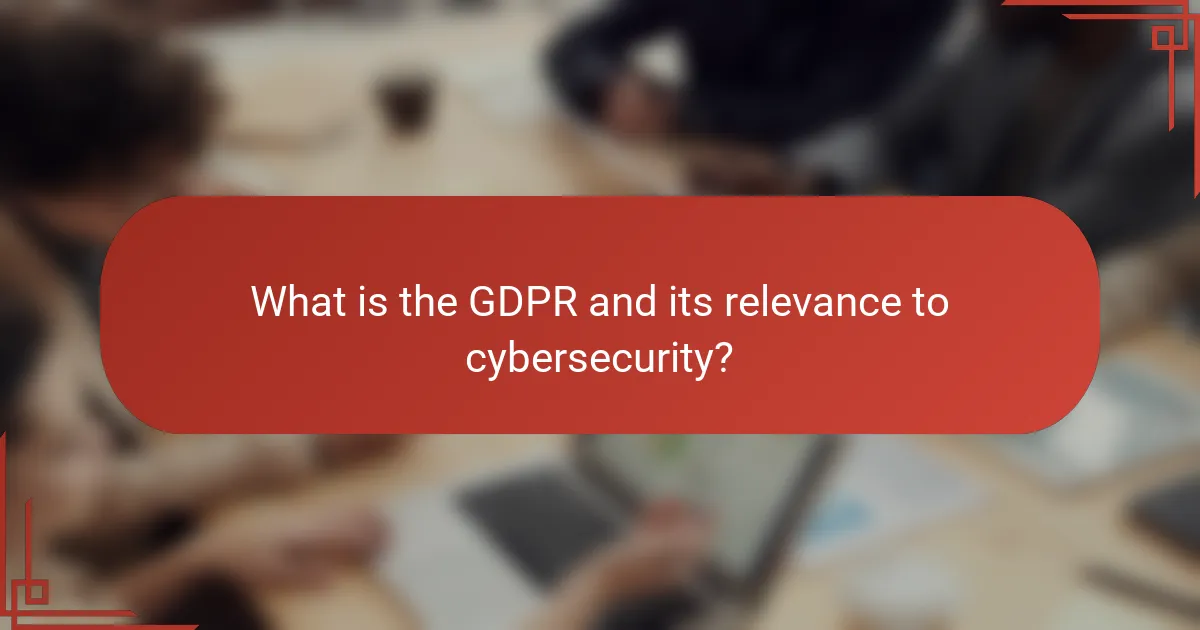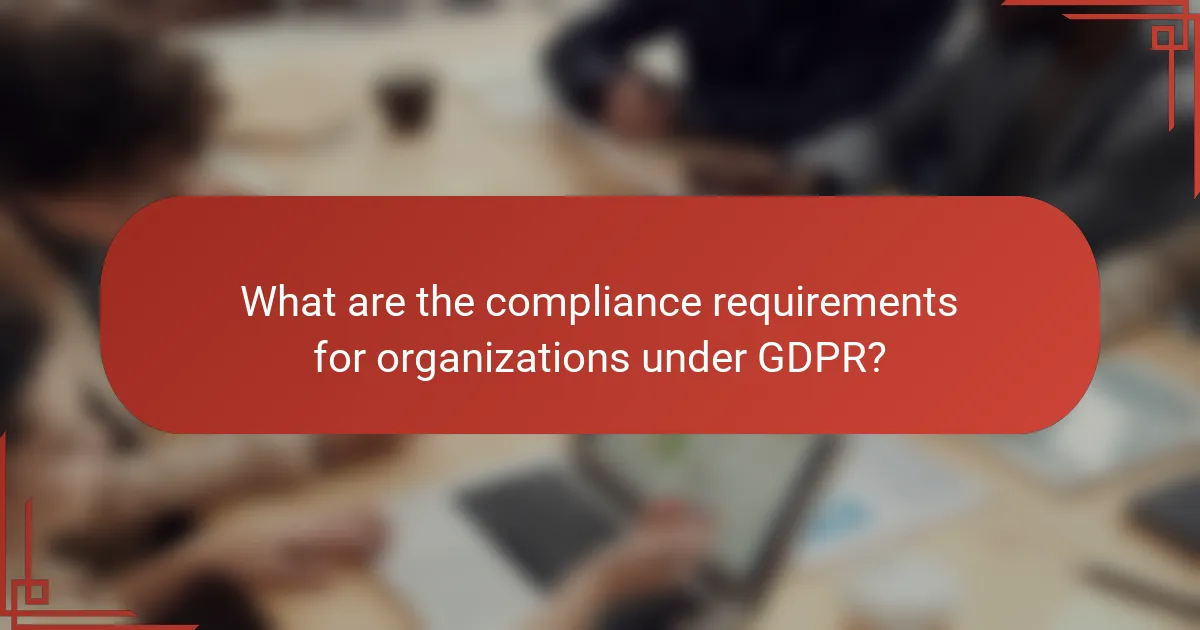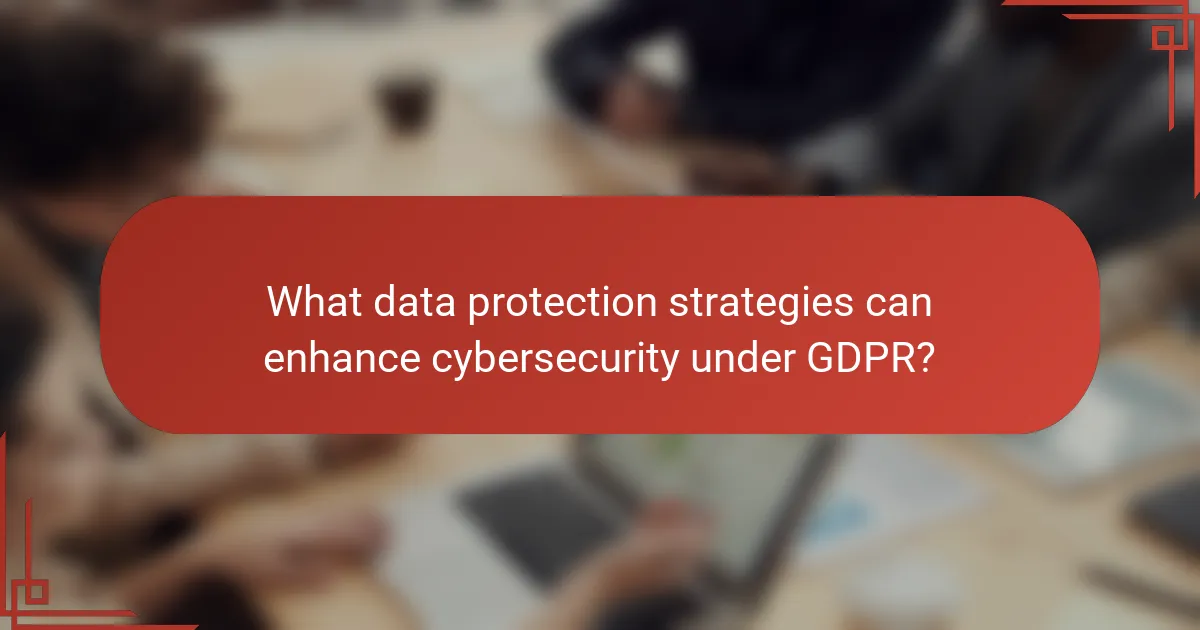The General Data Protection Regulation (GDPR) is a key data protection law in the European Union designed to enhance individual control over personal data. It establishes strict guidelines for data handling, storage, and processing, requiring organizations to implement robust security measures and conduct risk assessments. Compliance with GDPR is essential for fostering trust and accountability in data management, as non-compliance can lead to substantial fines. This article explores the impact of GDPR on cybersecurity, detailing compliance requirements, data protection strategies such as data minimization and encryption, and the importance of regular audits to ensure adherence to GDPR standards.

What is the GDPR and its relevance to cybersecurity?
The General Data Protection Regulation (GDPR) is a comprehensive data protection law in the European Union. It aims to enhance individuals’ control over their personal data. GDPR mandates strict guidelines for data handling, storage, and processing. Organizations must implement appropriate security measures to protect personal data. Non-compliance can result in significant fines, up to 4% of annual global turnover. This regulation is relevant to cybersecurity as it requires robust data protection strategies. Organizations must assess risks and establish protocols to prevent data breaches. Compliance with GDPR fosters trust and accountability in data management.
How does the GDPR define personal data?
The GDPR defines personal data as any information that relates to an identified or identifiable natural person. This includes names, identification numbers, location data, and online identifiers. The regulation emphasizes that personal data can be used to directly or indirectly identify a person. This definition encompasses a wide range of data types, ensuring comprehensive protection. The GDPR’s Article 4(1) explicitly states this definition, underscoring its importance in data protection laws.
What types of data are considered personal under the GDPR?
Personal data under the GDPR includes any information that relates to an identified or identifiable individual. This encompasses names, identification numbers, location data, and online identifiers. It also includes characteristics such as physical, physiological, genetic, mental, economic, cultural, or social identity. Sensitive personal data, which requires more stringent protection, includes racial or ethnic origin, political opinions, religious beliefs, trade union membership, health data, and [censured] orientation. The GDPR defines personal data broadly to ensure comprehensive protection for individuals’ privacy.
Why is the definition of personal data critical for cybersecurity?
The definition of personal data is critical for cybersecurity because it determines what information is protected under laws like GDPR. Personal data includes any information that can identify an individual, such as names, email addresses, and identification numbers. Understanding this definition helps organizations implement necessary security measures to protect sensitive information. Without a clear definition, companies may overlook critical data, leading to vulnerabilities. GDPR mandates that organizations assess their data processing activities, ensuring compliance and enhancing security. Non-compliance can result in significant fines, underscoring the importance of accurately defining personal data in cybersecurity strategies.
What are the core principles of GDPR compliance?
The core principles of GDPR compliance are lawfulness, fairness, and transparency. These principles require that personal data is processed legally and ethically. Purpose limitation ensures data is collected for specified, legitimate purposes only. Data minimization mandates that only necessary data is collected. Accuracy requires that personal data is kept up to date and corrected when necessary. Storage limitation dictates that personal data must be retained only as long as necessary for its purpose. Integrity and confidentiality demand that data is processed securely to prevent unauthorized access. Lastly, accountability emphasizes that organizations must demonstrate compliance with these principles.
How do the principles of data protection impact cybersecurity strategies?
The principles of data protection significantly influence cybersecurity strategies. Data protection principles, such as data minimization and purpose limitation, guide organizations in how they collect and process personal data. These principles necessitate robust security measures to prevent unauthorized access and data breaches. Compliance with data protection regulations, like GDPR, mandates that organizations implement specific cybersecurity protocols. These include encryption, access controls, and regular security assessments.
Organizations must also ensure data integrity and confidentiality as part of their cybersecurity strategies. Failing to adhere to data protection principles can result in severe penalties, reinforcing the need for effective cybersecurity measures. According to GDPR, organizations can face fines up to 4% of annual global turnover for non-compliance. This financial risk drives organizations to prioritize cybersecurity in their data protection strategies.
What obligations do organizations have under GDPR regarding data security?
Organizations have specific obligations under GDPR regarding data security. They must implement appropriate technical and organizational measures to ensure a level of security appropriate to the risk. This includes encryption, pseudonymization, and regular testing of security measures. Organizations are also required to conduct Data Protection Impact Assessments (DPIAs) when processing poses a high risk to individuals’ rights. In addition, they must ensure that any third-party processors also comply with GDPR security requirements. Furthermore, organizations must report data breaches to the relevant supervisory authority within 72 hours. These obligations are designed to protect personal data and uphold the rights of individuals as outlined in GDPR Article 32.

What are the compliance requirements for organizations under GDPR?
Organizations under GDPR must ensure data protection and privacy for individuals in the EU. They must appoint a Data Protection Officer if their activities involve large-scale processing of personal data. Organizations must also conduct Data Protection Impact Assessments for high-risk processing activities. They are required to maintain records of processing activities. Consent must be obtained from individuals before collecting their personal data. Additionally, they must implement appropriate technical and organizational measures to ensure data security. Organizations must also notify authorities of data breaches within 72 hours. Lastly, individuals have the right to access their data and request its deletion.
How can organizations ensure they are compliant with GDPR?
Organizations can ensure compliance with GDPR by implementing robust data protection policies. They must conduct regular data audits to identify personal data processing activities. Organizations should also appoint a Data Protection Officer (DPO) to oversee compliance efforts. Training employees on data protection principles is essential for maintaining awareness.
Establishing clear consent mechanisms for data collection is necessary under GDPR. Organizations must ensure that individuals can easily access, correct, and delete their personal data. Implementing strong data security measures, such as encryption, helps protect personal data from breaches.
Regularly reviewing and updating privacy policies ensures they reflect current practices. Organizations should maintain documentation of data processing activities as proof of compliance. These steps collectively help organizations meet GDPR requirements effectively.
What steps should organizations take to assess their current compliance status?
Organizations should conduct a compliance audit to assess their current status. This involves reviewing policies and procedures against GDPR requirements. Organizations must identify applicable regulations and data processing activities. They should evaluate existing data protection measures and their effectiveness. Additionally, organizations should engage stakeholders to gather insights on compliance practices. Documenting findings is crucial for tracking compliance gaps. Regular training sessions for staff can enhance awareness of compliance obligations. Finally, organizations should implement a continuous monitoring process to ensure ongoing compliance.
How often should organizations review their GDPR compliance?
Organizations should review their GDPR compliance at least annually. Regular reviews help ensure ongoing adherence to the regulation. The GDPR does not specify a frequency for reviews, but best practices suggest annual assessments. This timeframe allows organizations to adapt to any changes in data processing activities or legal interpretations. Additionally, organizations should conduct reviews after significant changes, such as new data processing technologies or operational shifts. Continuous monitoring is essential to identify potential risks and gaps in compliance. This proactive approach minimizes the risk of non-compliance penalties, which can be substantial.
What role does data protection impact assessment (DPIA) play in compliance?
A Data Protection Impact Assessment (DPIA) plays a crucial role in compliance with data protection laws. It helps organizations identify and mitigate risks associated with data processing activities. DPIAs are mandated under the General Data Protection Regulation (GDPR) for high-risk processing. Conducting a DPIA demonstrates accountability and transparency in data handling practices. It involves assessing the necessity and proportionality of processing personal data. The process includes consulting stakeholders and documenting findings. Failure to conduct a DPIA when required can lead to regulatory penalties. According to GDPR Article 35, a DPIA is essential for ensuring that privacy risks are addressed proactively.
When is a DPIA required under GDPR?
A Data Protection Impact Assessment (DPIA) is required under GDPR when processing is likely to result in a high risk to the rights and freedoms of individuals. This requirement is specified in Article 35 of the GDPR. A DPIA must be conducted for types of processing such as systematic and extensive evaluation of personal data, large-scale processing of sensitive data, or monitoring of publicly accessible areas. Organizations must assess risks related to data processing activities. If a DPIA indicates that risks cannot be mitigated, the supervisory authority must be consulted prior to processing. This ensures compliance with GDPR and protects individuals’ privacy rights.
What are the key components of an effective DPIA?
The key components of an effective Data Protection Impact Assessment (DPIA) include a clear description of the processing activity, an assessment of necessity and proportionality, an evaluation of risks to data subjects, and the identification of measures to mitigate those risks. A clear description outlines the purpose and scope of data processing. Assessing necessity ensures that the processing is essential for the intended purpose. Evaluating risks involves identifying potential impacts on individual rights and freedoms. Finally, identifying mitigation measures helps to reduce the identified risks. These components align with GDPR requirements, ensuring compliance and enhancing data protection strategies.

What data protection strategies can enhance cybersecurity under GDPR?
Data protection strategies that enhance cybersecurity under GDPR include data minimization, encryption, and regular audits. Data minimization limits the collection of personal data to what is necessary for specific purposes. This reduces the risk of exposure in case of a breach. Encryption protects data by converting it into a secure format that unauthorized users cannot access. Regular audits help identify vulnerabilities and ensure compliance with GDPR requirements. Implementing these strategies can lead to improved data security and reduced risk of penalties. According to the European Data Protection Board, effective data protection measures are crucial for maintaining trust and safeguarding personal data.
How can encryption be utilized as a data protection strategy?
Encryption can be utilized as a data protection strategy by converting sensitive information into a secure format. This process ensures that only authorized users can access the data. Encryption protects data at rest, in transit, and during processing. For example, encrypting files on a server prevents unauthorized access. Additionally, encrypting communications, such as emails, safeguards against interception. The General Data Protection Regulation (GDPR) recognizes encryption as a valid security measure. According to GDPR Article 32, encryption is recommended to ensure data confidentiality and integrity. Implementing encryption can significantly reduce the risk of data breaches and enhance compliance with regulatory requirements.
What types of encryption are most effective for GDPR compliance?
AES (Advanced Encryption Standard) and RSA (Rivest-Shamir-Adleman) are the most effective types of encryption for GDPR compliance. AES is a symmetric encryption algorithm widely recognized for its security and efficiency. It encrypts data in fixed-size blocks, making it suitable for protecting sensitive information. RSA is an asymmetric encryption algorithm used for secure data transmission. It employs key pairs to encrypt and decrypt information, ensuring secure communications. Both AES and RSA meet GDPR requirements for data protection and privacy. They help organizations secure personal data, reducing the risk of breaches. Compliance with GDPR mandates data encryption as a critical security measure.
How does encryption safeguard personal data from breaches?
Encryption safeguards personal data from breaches by converting it into a secure format that is unreadable without a decryption key. This process protects sensitive information during storage and transmission. When data is encrypted, unauthorized users cannot access the content even if they intercept it. For instance, the Advanced Encryption Standard (AES) is widely used to secure data, ensuring that only authorized parties can decrypt and read the information. According to the National Institute of Standards and Technology (NIST), encryption significantly reduces the risk of data breaches. In fact, organizations that implement encryption are less likely to experience costly data breaches, as highlighted in a report by IBM Security, which states that the average cost of a data breach is reduced by $370,000 when encryption is utilized.
What are best practices for data breach response under GDPR?
Organizations must follow specific best practices for data breach response under GDPR. First, they should establish an incident response plan before a breach occurs. This plan should include clear roles and responsibilities for team members. Second, organizations must assess the breach promptly and determine its severity. Third, they are required to notify the relevant supervisory authority within 72 hours of becoming aware of the breach. If the breach poses a high risk to individuals, affected parties must also be informed without undue delay. Fourth, organizations should document the breach and their response actions thoroughly. This documentation is crucial for demonstrating compliance with GDPR. Lastly, they should conduct a post-breach review to improve future response strategies. These practices align with GDPR Article 33 and Article 34, which outline the obligations for data breach notifications.
What steps should organizations take immediately following a data breach?
Organizations should take immediate action to mitigate the effects of a data breach. First, they must contain the breach to prevent further data loss. This involves isolating affected systems and disabling compromised accounts. Next, organizations should assess the scope of the breach. They need to identify what data was accessed or stolen.
After assessing the breach, organizations must notify affected individuals promptly. GDPR mandates that notifications occur within 72 hours of becoming aware of the breach. Additionally, organizations should report the breach to relevant authorities. This is essential for compliance with GDPR regulations.
Lastly, organizations should conduct a thorough investigation. This helps understand the cause of the breach and develop strategies to prevent future incidents. Implementing stronger security measures is crucial for enhancing data protection.
How can organizations effectively communicate a data breach to affected individuals?
Organizations can effectively communicate a data breach to affected individuals by promptly notifying them with clear and concise information. They should provide details about the nature of the breach, including what data was compromised. Organizations must also inform individuals about the potential risks associated with the breach. They should outline the steps being taken to mitigate the impact and prevent future occurrences. Offering guidance on protective measures, such as changing passwords or monitoring accounts, is essential. Transparency is crucial; organizations should maintain open lines of communication for further inquiries. According to GDPR Article 34, organizations are required to notify individuals without undue delay when there is a high risk to their rights and freedoms. This legal framework emphasizes the importance of timely and clear communication in maintaining trust.
What are the common challenges organizations face in achieving GDPR compliance?
Organizations face several common challenges in achieving GDPR compliance. One major challenge is understanding the complex regulations. GDPR has intricate requirements that can be difficult to interpret. Another challenge is data mapping. Organizations often struggle to identify and document all personal data they hold. This includes knowing where data is stored and how it flows within the organization.
Additionally, ensuring consent management can be problematic. Organizations must obtain clear consent from individuals for data processing, which can be challenging to implement effectively. Resource allocation is also a significant hurdle. Many organizations lack the necessary personnel or budget to meet compliance requirements.
Moreover, maintaining ongoing compliance presents a challenge. GDPR compliance is not a one-time effort; it requires continuous monitoring and updates. Finally, organizations may face difficulties in training staff. Employees need to be educated on data protection practices to ensure compliance. These challenges highlight the complexity of achieving GDPR compliance in today’s data-driven environment.
How can organizations overcome resource limitations in compliance efforts?
Organizations can overcome resource limitations in compliance efforts by prioritizing tasks and leveraging technology. They should conduct a thorough risk assessment to identify critical compliance areas. This helps in allocating resources efficiently. Investing in compliance management software can streamline processes and reduce manual workload. Training staff on compliance requirements can also enhance efficiency without significant financial investment. Collaborating with third-party vendors for specialized compliance services can provide expertise without the need for full-time hires. Additionally, sharing resources with industry peers can mitigate costs. These strategies are supported by the fact that organizations that adopt technology-driven compliance solutions report a 30% reduction in compliance costs, according to a study by the Compliance, Governance and Oversight Council.
What role does employee training play in maintaining GDPR compliance?
Employee training plays a crucial role in maintaining GDPR compliance. It ensures that employees understand data protection principles and their responsibilities under GDPR. Training helps in recognizing personal data and the importance of consent. Employees learn how to handle data breaches and the procedures for reporting them. Regular training updates employees on changes in regulations and best practices. A well-informed workforce reduces the risk of non-compliance and potential fines. Organizations with effective training programs are better equipped to protect sensitive information. This proactive approach fosters a culture of data protection within the organization.
What practical tips can organizations implement to enhance GDPR compliance and cybersecurity?
Organizations can enhance GDPR compliance and cybersecurity by implementing several practical strategies. First, they should conduct regular data audits to identify personal data held and its usage. This helps ensure that data processing activities are transparent and compliant with GDPR requirements. Second, organizations must establish clear data protection policies and procedures. These policies should outline the handling of personal data and the rights of individuals under GDPR.
Third, training employees on data protection principles is essential. Staff should understand their responsibilities regarding personal data and the implications of data breaches. Fourth, organizations should implement strong access controls to limit data access to authorized personnel only. This reduces the risk of unauthorized access and potential data breaches.
Fifth, encryption of personal data is a critical step. Encrypting data both at rest and in transit protects it from unauthorized access. Sixth, organizations should adopt a robust incident response plan. This plan should detail the steps to take in the event of a data breach, including notifying affected individuals and regulatory authorities.
Lastly, organizations should regularly review and update their compliance practices. GDPR requirements may evolve, and staying informed ensures ongoing compliance. By following these practical tips, organizations can significantly enhance their GDPR compliance and cybersecurity posture.
The main entity of the article is the General Data Protection Regulation (GDPR), which significantly influences cybersecurity practices. The article outlines GDPR’s relevance to data protection, detailing the definition of personal data and the core compliance principles organizations must follow. It discusses the obligations organizations have under GDPR, including implementing data security measures, conducting Data Protection Impact Assessments (DPIAs), and ensuring effective communication during data breaches. Additionally, the article highlights practical strategies for enhancing GDPR compliance and cybersecurity, such as employee training, data audits, and encryption, emphasizing the importance of these measures in safeguarding personal data and maintaining regulatory compliance.


